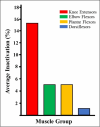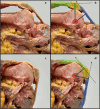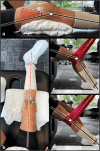Oh, My Quad: A Clinical Commentary And Evidence-Based Framework for the Rehabilitation of Quadriceps Size and Strength after Anterior Cruciate Ligament Reconstruction
- PMID: 39628771
- PMCID: PMC11611527
- DOI: 10.26603/001c.126191
Oh, My Quad: A Clinical Commentary And Evidence-Based Framework for the Rehabilitation of Quadriceps Size and Strength after Anterior Cruciate Ligament Reconstruction
Abstract
Quadriceps weakness after anterior cruciate ligament reconstruction (ACLR) is a well-known phenomenon, with more persistent quadriceps weakness observed after ACLR with a bone-patellar tendon-bone or quadriceps tendon autograft than with a hamstring tendon autograft. Longstanding quadriceps weakness after ACLR has been associated with suboptimal postoperative outcomes and the progression of radiographic knee osteoarthritis, making the recovery of quadriceps size and strength a key component of ACLR rehabilitation. However, few articles have been written for the specific purpose of optimizing quadriceps size and strength after ACLR. Therefore, the purpose of this review article is to integrate the existing quadriceps muscle basic science and strength training literature into a best-evidence synthesis of exercise methodologies for restoring quadriceps size and strength after ACLR, as well as outline an evidence-informed quadriceps load-progression for recovering the knee's capacity to manage the force-profiles associated with high-demand physical activity. Level of Evidence: 5.
Keywords: ACL; exercise selection; hypertrophy training; muscle; physical therapy; strength training.
© The Author(s).
Conflict of interest statement
The above authors have no conflicts of interest related to the development and publication efforts of this manuscript. The authors certify that they have no affiliations with or financial involvement in any organization or entity with a direct financial interest in the subject matter or materials discussed in this manuscript.
Figures













References
-
- Anterior cruciate ligament injury risk in sport: A systematic review and meta-analysis of injury incidence by sex and sport classification. Montalvo A. M., Schneider D. K., Webster K. E.., et al. 2019J Athl Train. 54(5):472–482. doi: 10.4085/1062-6050-407-16. https://doi.org/10.4085/1062-6050-407-16 - DOI - DOI - PMC - PubMed
-
- Anatomical versus non-anatomical single bundle anterior cruciate ligament reconstruction: A cadaveric study of comparison of knee stability. Lim H.-C., Yoon Y.-C., Wang J.-H., Bae J.-H. 2012Clin Orthop Surg. 4(4):249. doi: 10.4055/cios.2012.4.4.249. https://doi.org/10.4055/cios.2012.4.4.249 - DOI - DOI - PMC - PubMed
-
- Anatomical anterior cruciate ligament reconstruction (ACLR) results in fewer rates of atraumatic graft rupture, and higher rates of rotatory knee stability: a meta-analysis. Eliya Y., Nawar K., Rothrauff B. B., Lesniak B. P., Musahl V., de SA D. 2020Journal of ISAKOS. 5:359–370. doi: 10.1136/jisakos-2020-000476. https://doi.org/10.1136/jisakos-2020-000476 - DOI - DOI
-
- Treatment after anterior cruciate ligament injury: Panther Symposium ACL Treatment Consensus Group. Diermeier T., Rothrauff B. B., Engebretsen L.., et al. 2020Orthop J Sports Med. 8:232596712093109. doi: 10.1177/2325967120931097. https://doi.org/10.1177/2325967120931097 - DOI - DOI - PMC - PubMed
-
- Why bone-patella tendon-bone grafts should still be considered the gold standard for anterior cruciate ligament reconstruction. Carmichael J. R., Cross M. J. 2009Br J Sports Med. 43:323–325. doi: 10.1136/bjsm.2009.058024. https://doi.org/10.1136/bjsm.2009.058024 - DOI - DOI - PubMed
LinkOut - more resources
Full Text Sources
